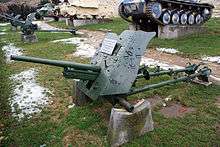4.2 cm Pak 41
| 4.2 cm Pak 41 | |
|---|---|
 | |
| Type | Anti-tank gun |
| Place of origin | Nazi Germany |
| Service history | |
| Used by | Germany |
| Wars | World War II |
| Production history | |
| Produced | 1941–42 |
| Number built | 313 |
| Specifications | |
| Weight | 642 kg (1,000 lb) |
| Length | 235 cm (7 ft 9 in) |
| Barrel length | 211.4 cm (6 ft 11 in) L/52 |
|
| |
| Shell | 42 × 406 mm. R |
| Caliber | 28-42 mm (1.1-1.6 in) |
| Breech | horizontal sliding block |
| Carriage | split trail |
| Elevation | -8° to +25° |
| Traverse | 60° |
| Muzzle velocity | 1,265 m/s (4,150 ft/s) |
| Effective firing range | 1,000 m (1,000 yd) |
The 4.2 cm Pak 41 was a light anti-tank gun issued to German airborne units in World War II. This gun was externally similar to the 3.7 cm Pak 36, using a modified version of the latter's carriage, but used the squeeze bore principle (in German called Gerlich after Hermann Gerlich, who developed the principle in the 1920s, reportedly for a hunting rifle) to boost its velocity, and hence armour-piercing ability. The bore had a diameter of 42 mm at the chamber, but tapered down to 28 mm at the muzzle. Production was terminated in May 1942 after the delivery of 136 guns. By November 1944, 41 remained in service.
Specifications
- Projectile weight: AP 0.336 kg (12 ounces)
| Range | Penetration at 0 degrees from vertical | Penetration at 30 degrees from vertical | ||
|---|---|---|---|---|
| Source: | Gander&Chamberlain[1] | Hogg[2] | Gander&Chamberlain[1] | Hogg[2] |
| 0 m | 124 mm | - mm | 95 mm | - mm |
| 100 m | - mm | 120 mm | - mm | 90 mm |
| 250 m | 105 mm | - mm | 83 mm | mm |
| 500 m | 87 mm | 87 mm | 72 mm | 72 mm |
| 750m | 70 mm | - mm | 62 mm | - mm |
| 1000 m | 60 mm | 60 mm | 53 mm | 53 mm |
See also
References
- Gander, Terry and Chamberlain, Peter. Weapons of the Third Reich: An Encyclopedic Survey of All Small Arms, Artillery and Special Weapons of the German Land Forces 1939-1945. New York: Doubleday, 1979 ISBN 0-385-15090-3
- Hogg, Ian V. German Artillery of World War Two. 2nd corrected edition. Mechanicsville, PA: Stackpole Books, 1997 ISBN 1-85367-480-X
- 1 2 German translation of the book "Small Arms, Artillery and Special Weapons of the Third Reich. An encyclopedic survey" by T. Gander and P. Chamberlain (Jane's Publishers Ltd) from 2005 (ISBN 3613024810)
- 1 2 "German Artillery of World War Two" by Ian V. Hogg, corrected 1997 reprint
This article is issued from Wikipedia - version of the 7/19/2016. The text is available under the Creative Commons Attribution/Share Alike but additional terms may apply for the media files.
